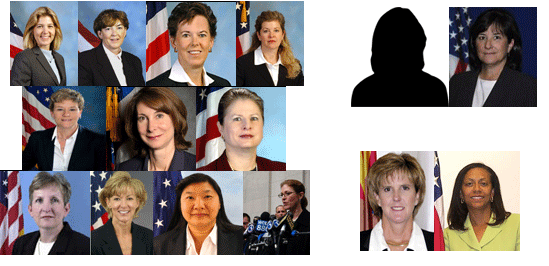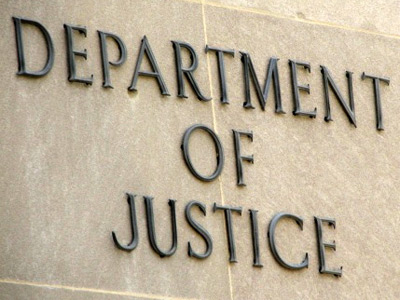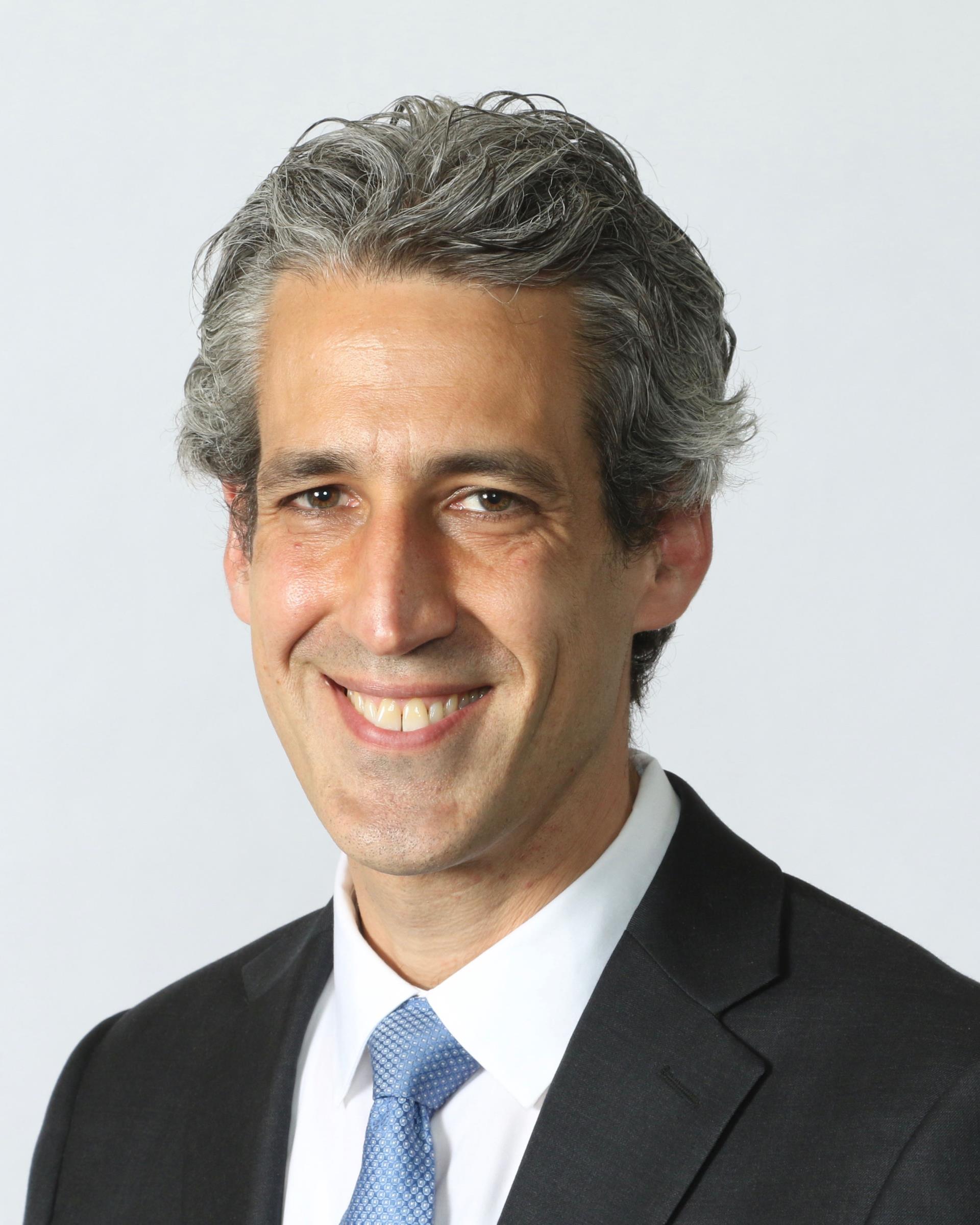
Far left block: FBI top row: l-r Amy Hess-Memphis, Valerie Parlave-Little Rock, Janice K. Fedarcyk-Philadelphia, Elizabeth Fries-Louisville; FBI Middle Row: l-r Amy Pickett-N.Y., Stephanie Douglas-San Francisco, Laura M. Laughlin-Seattle; FBI Bottom Row: l-r Charlene B. Thornton-Honolulu, Daphne Hearn-L.A., Carol K.O. Lee-Albuquerque, Kimberly K. Mertz-New Haven; Far Right Block: ATF Top Row: l-r Virginia O’Brien-Tampa, Theresa Stoop-Baltimore; DEA Bottom Row: l-r Elizabeth W. Kempshall-Phoenix, Ava A. Cooper-Davis-Washington D.C.
WASHINGTON – In 1966, soul singer James Brown belted out his hit “It’s a Man’s Man’s Man’s World.” Well, 46 years later, in the world of federal law enforcement, men still far out number women, but woman have made some notable inroads.
At tickelthewire.com, we decided to examine the progress by taking a snapshot of a key area of management — Special Agents in Charge (SAC) of a field offices at three key Justice Department law enforcement agencies — the FBI, DEA and ATF.
A review of each field office shows that women fared best at the FBI where they held 9 of 56 SAC posts as heads of the field offices. At the DEA, 2 of 21 offices were headed up by woman, and at ATF 2 of 25. Additionally at the FBI, two women hold SAC positions – one in Los Angeles and one in New York – but they do not head up those offices. Those offices are so big that they are headed up by an Assistant Director in charge, who supervises multiple SACs.
Some think the federal agencies need to try harder.
“I think federal agencies need to do more outreach and target women, this job is a really good match,” says Margaret Moore, who became the first female SAC for ATF in 1993, who retired from agency and is now executive director of WIFLE (Women in Federal Law Enforcement), which works to achieve gender equity in federal law enforcement.
” Women are good communicators; they’re good at analyzing and multi-tasking. It’s about connecting the dots and not kicking down the doors,” said Moore.
UPDATE: June 25: Denise Fedarcyk, the SAC for the Philly FBI, has been named to head up the New York office. Her title will change from SAC to assistant director in charge. She is the first female to head up that office.
It took a while for women to rise through the ranks to become SACs, for a variety of reasons. Some critics say the agencies for a period of time hadn’t focused enough on recruiting and nurturing women to move up the ladder to the SAC posts, a coveted position in federal law enforcement.
And there were — and remain –other challenges as well, according to an FBI website.
“Unfortunately, some women are hesitant to apply to become Special Agents because of misperceptions they have about the job and the FBI,” the FBI website said. “Some think that candidates for the position of FBI Special Agent must have law enforcement, criminology, or related experience. Or that Special Agents must be men. Nothing could be further from the truth.”
It wasn’t until 1998 that the DEA assigned its first SAC — Michele Leonhart, who now heads up the agency. Margaret Moore of WIFLE was the first ATF SAC in 1993 and Burdena Pasenelli became the first female SAC for the FBI in 1992 when she headed up the Alaska office.
Kathleen McChensey, a former SAC in Portland and Chicago, says the number of SACs is still ” a little low in percentage. It is growing and it does take time because the requirements to be a SAC are very rigorous and extensive so it takes time to get to that point.”
But she said the FBI needs to continually evaluate the positions of women and other minorities and make sure they are represented in all areas of the agency, and no one is precluded.
Kimberly Mertz, special agent in charge of the New Haven, Conn., FBI office, said she “adamantly opposes” any kind of quotas, and noted that the FBI’s career management program is voluntary and “opportunities in management are self-initiated.”
“I believe the most qualified individual should be selected for a position and that gender should not be taken into account in that decision making process and result in the promotion of an individual who is not assessed as being the most qualified,” she said. “While I fully recognize the importance of diversity in the FBI, in all positions, I do not believe standards should, or need to be lowered in order to achieve it.”
The DEA, the only one of the three agencies headed by a woman, issued a statement to ticklethewire.com in response to inquiries about the number of female SACS.
“As of September 2009, women made up 9.4 percent of the 4,893 special agents who work for the Drug Enforcement Administration. Currently 2 of the 21 (9.5%) filled Special Agent in Charge (SAC) positions are held by women,” the DEA said. “DEA is extremely proud of the significant contributions made by the more than 3,400 women who work throughout the agency.”
ATF in a statement remarked:
“ATF employs and recruits highly skilled, motivated, diverse individuals for its workforce. ATF provides a tremendous opportunity for individuals who want to make a difference in the quality of life in communities.
“Currently there are seven women in senior executive service at ATF; five serve in executive positions and are part of the strategic leadership team at ATF headquarters and two serve as Special Agents in Charge in ATF field divisions.”
Women weren’t always welcomed with open arms in federal law enforcement. In May of 1924, just 16 days after taking over the FBI Director J. Edgar Hoover pushed out two of agency’s three female agents, according to the book “The FBI: A History” by Rhodri Jeffrey-Jones. The third agent , Lenore Houston resigned in 1928, the book reported. After that, Hoover never had another female agent up until his death on May 2, 1972. Shortly after, the FBI started hiring women agents.
The ranks of women grew in the agency. But still, all did not always go smoothly. In 1995, a group of female agents threatened to sue the bureau over concerns, but the agency sat down with them and agreed to make some changes, according to a June 2009 Washington Post article.
Today, the FBI says that 2,601 or about 20 percent of agency’s 13,617 agents are women.
“Female Special Agents are critical members of the FBI team,” the FBI website says. “They contribute unique and important perspectives, experiences, and skills. In many cases, women possess different analytical skills, approach problems differently, and have different talents and abilities than do men.”
“These different skills, approaches, and talents often spell the difference between success and failure on a case or investigation. We have found that investigative teams composed of a blend of female and male Special Agents are much more effective at bringing complex investigations to a speedy and successful resolution.”
Amy L. Pickett, an acting special agent in charge in New York, said she believes “women now do have the same opportunities as men to rise in management. Although there may have been issues in the past, these are becoming less as more women enter management.”
“As these women move up, there will be a natural progression of women becoming SACs. So, it isn’t a matter of should there be more or not, it is simply a reality that the numbers will ensure there are more women SACs than we see today.”
Echoing those similar remarks, Daphne Hearn, an FBI special agent in charge in Los Angeles, said:
“I have been given incredible opportunities within the FBI and have always been treated fairly and with the utmost respect. All FBI employees are given equal opportunities for promotion whether they are male or female. The FBI makes every effort to promote our best leaders regardless of gender and is currently developing a leadership initiative to develop leadership skills in all FBI employees, not just within our executive managers.”




